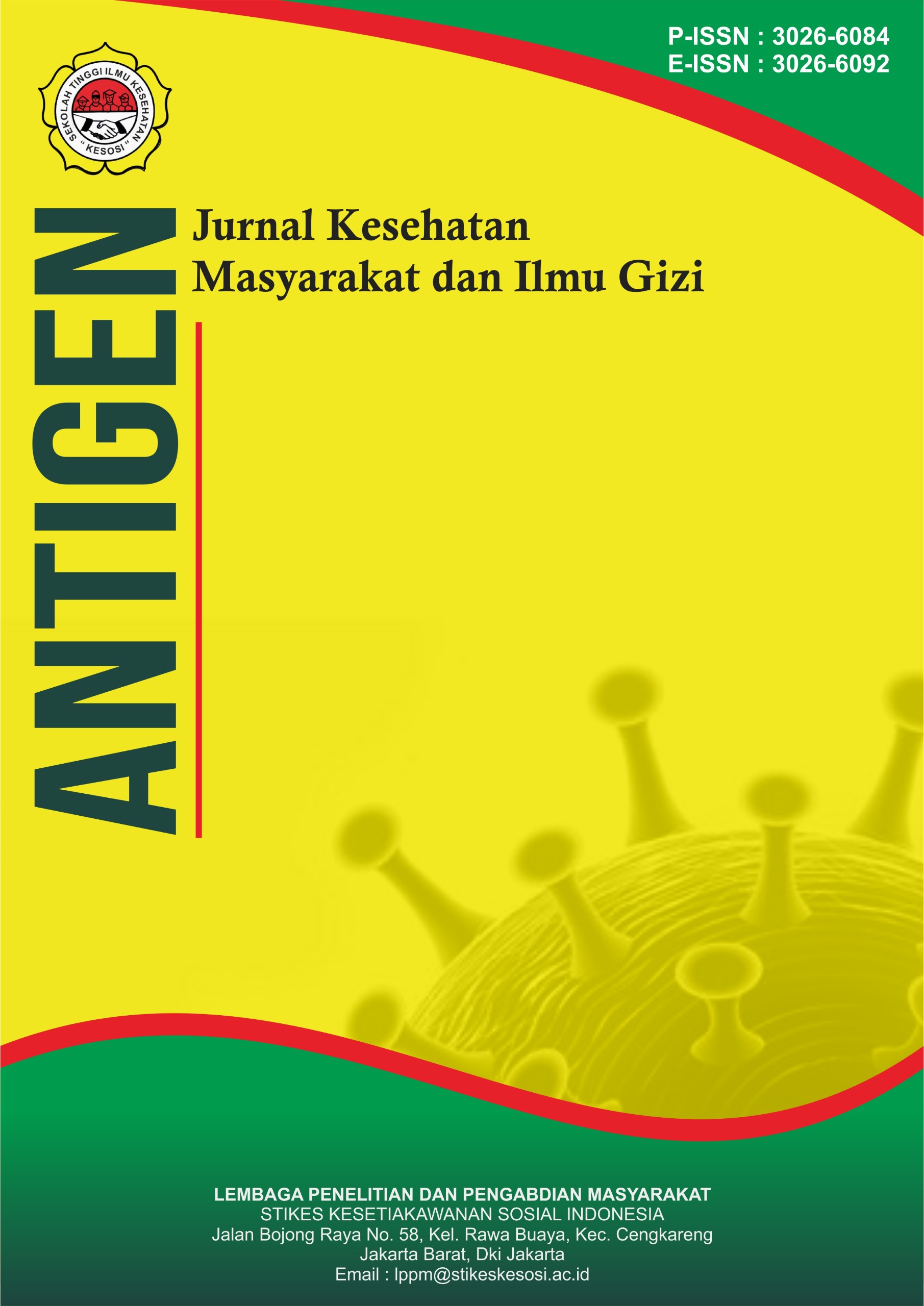Prediksi Penyakit Diabetes Mellitus Tipe I dan Tipe II Menggunakan Metode KNN di Klinik Dharma Husada
DOI:
https://doi.org/10.57213/antigen.v2i3.303Keywords:
Diabetes Mellitus, KNN, DatasetAbstract
Diabetes Mellitus (DM) is a metabolic disorder characterized by high blood sugar levels due to insulin deficiency. Factors causing Diabetes Mellitus (DM) are lifestyle which includes diet, lack of exercise, monitoring blood sugar, and medication. Most people do not realize that they have DM and only find out when they experience severe symptoms. To avoid this, the k-Nearest Neighbor (KNN) method can be used to predict the possibility of developing diabetes. The aim of this research is to classify diabetes mellitus using the K-Nearest Neighbor (KNN) method and make people more aware of the risk of disease through healthy lifestyle changes. Data received from the Dharma Husada Clinic is categorized based on researchers' needs, including age, BMI, insulin, skin thickness, glucose, diabetes, genetics, and insulin. This research was carried out in three main steps: dataset input, preprocessing, and evaluation. The first stage is data analysis which begins by entering a dataset to train and test the model, where each data element has certain characteristics (attributes) and classes. Preprocessing steps include training data generation and data cleaning, which includes sanitization, lowercase, normalization, stopwords, stemming, and tokenizing. The final step is evaluating. Evaluation includes building an evaluation model and measuring the level of accuracy, building a predictive model, and saving the model. This research shows that the K-Nearest Neighbor (KNN) method can be used to classify diabetes mellitus (DM), but especially in a small dataset consisting of 245 dates and 8 attributes it is not accurate for patients aged 30 years. . A k value that is too small can cause overfitting, and a k value that is too large can cause underfitting. However, if the amount of data is small, the choice of k can have a large impact.
References
Admojo, F. T., & Sulistya, Y. I. (2022). Analisis Performa Algoritma Stochastic Gradient Descent (SGD) Dalam Mengklasifikasi Tahu Berformalin. Indonesian Journal of Data and Science, 3(1), 1–8. https://doi.org/10.56705/ijodas.v3i1.42
Guarango, P. M. (2022). No Title 8.5.2017, Analisis Pengelolaan Pola Makan Yang Berpengaruh Terhadap Gula Darah Penderita DM, 2003–2005.
Hardianto, D. (2021). Telaah Komprehensif Diabetes Melitus: Klasifikasi, Gejala, Diagnosis, Pencegahan, Dan Pengobatan. Jurnal Bioteknologi & Biosains Indonesia (JBBI), 7(2), 304–317. https://doi.org/10.29122/jbbi.v7i2.4209
Hasanah, L. U., Natasya, R. P., & Utami, V. D. (2024). Penerapan Algoritma K-Nearest Neighbor (Knn) Untuk Diagnosis Penyakit Diabetes Melitus. Jurnal Ilmu Komputer Revolusioner, 8(1), 86–89.
Irwansyah, I., & Kasim, I. S. (2021). Indentifikasi Keterkaitan Lifestyle Dengan Risiko Diabetes Melitus. Jurnal Ilmiah Kesehatan Sandi Husada, 10(1), 62–69. https://doi.org/10.35816/jiskh.v10i1.511
Mahalisa, G., & Arminarahmah, N. (2022). Diabetes Classification Analysis Using the Euclidean Distance Method Based on the K-Nearest Neighbors Algorithm. JTKSI (Jurnal Teknologi Komputer Dan Sistem Informasi), 5(3), 178. https://doi.org/10.56327/jtksi.v5i3.1249
Marzel, R. (2020). Terapi pada DM Tipe 1. Jurnal Penelitian Perawat Profesional, 3(1), 51–62. https://doi.org/10.37287/jppp.v3i1.297
Melinda, Khasanah, S., & Susanto, A. (2022). Gambaran Kadar Gula Darah Penderita Diabetes Mellitus Peserta Prolanis di Puskesmas 1 Sumbang Kabupaten Banyumas. Jurnal Inovasi Penelitian, 3(6), 6657–6670.
Nesyifa, N., & Huriah, T. (2023). Studi Kasus Penerapan Senam Kaki DM DAN Edukasi Rokok Dalam Peningkatan Sirkulassi Dan Pengetahuan Klien Diabetes Mellitus Tipe 2 Dan Perokok Aktif. Nursinng Sciene Journal, 4(1), 79–86.
Norma Lalla, N. S., & Rumatiga, J. (2022a). Ketikdakstabilan Kadar Glukosa Darah Pada Pasien Diabetes Melitus Tipe II. Jurnal Ilmiah Kesehatan Sandi Husada, 473–479. https://doi.org/10.35816/jiskh.v11i2.816
Norma Lalla, N. S., & Rumatiga, J. (2022b). Ketikdakstabilan Kadar Glukosa Darah Pada Pasien Diabetes Melitus Tipe II. Jurnal Ilmiah Kesehatan Sandi Husada, December, 473–479. https://doi.org/10.35816/jiskh.v11i2.816
Pratiwi, I. A. A. S., & Wijayanto, A. W. (2019). Klasifikasi Indeks Pembangunan Manusia dengan Metode K-Nearest Neighbor dan Support Vector Machine di Pulau Jawa. Jurnal Ilmu Komputer, 15(1), 8–21. https://ojs.unud.ac.id/index.php/jik/article/download/68565/44248
Rochmah, N. S. M. F. L. (2019). Tatalaksana Poliuria pada Anak dalam Praktek Sehari-Hari. 1–113.
Sholeh, M., Andayati, D., & Rachmawati, R. Y. (2022). Data Mining Model Klasifikasi Menggunakan Algoritma K-Nearest Neighbor Dengan Normalisasi Untuk Prediksi Penyakit Diabetes. TeIKa, 12(02), 77–87. https://doi.org/10.36342/teika.v12i02.2911
Sidik, A. D. W. M., Himawan Kusumah, I., Suryana, A., Edwinanto, Artiyasa, M., & Pradiftha Junfithrana, A. (2020). Gambaran Umum Metode Klasifikasi Data Mining. FIDELITY : Jurnal Teknik Elektro, 2(2), 34–38. https://doi.org/10.52005/fidelity.v2i2.111
Silalahi, A. P., & Simanullang, H. G. (2023). Supervised Learning Metode K-Nearest Neighbor Untuk Prediksi Diabetes Pada Wanita. METHOMIKA Jurnal Manajemen Informatika Dan Komputerisasi Akuntansi, 7(1), 144–149. https://doi.org/10.46880/jmika.vol7no1.pp144-149
Suryati, E., Styawati, & Aldino, A. A. (2023). Analisis Sentimen Transportasi Online Menggunakan Ekstraksi Fitur Model Word2vec Text Embedding Dan Algoritma Support Vector Machine (SVM). Jurnal Teknologi Dan Sistem Informasi, 4(1), 96–106. https://doi.org/10.33365/jtsi.v4i1.2445
Suyani, S. (2022). Faktor-Faktor Yang Berhubungan Dengan Kejadian Bblr. JKM (Jurnal Kesehatan Masyarakat) Cendekia Utama, 10(2), 199. https://doi.org/10.31596/jkm.v10i2.1069
Downloads
Published
Issue
Section
License
Copyright (c) 2024 Antigen : Jurnal Kesehatan Masyarakat dan Ilmu Gizi

This work is licensed under a Creative Commons Attribution-ShareAlike 4.0 International License.






